SUZUKI SWIFT 2000 1.G Transmission Service Workshop Manual
Manufacturer: SUZUKI, Model Year: 2000, Model line: SWIFT, Model: SUZUKI SWIFT 2000 1.GPages: 447, PDF Size: 10.54 MB
Page 251 of 447
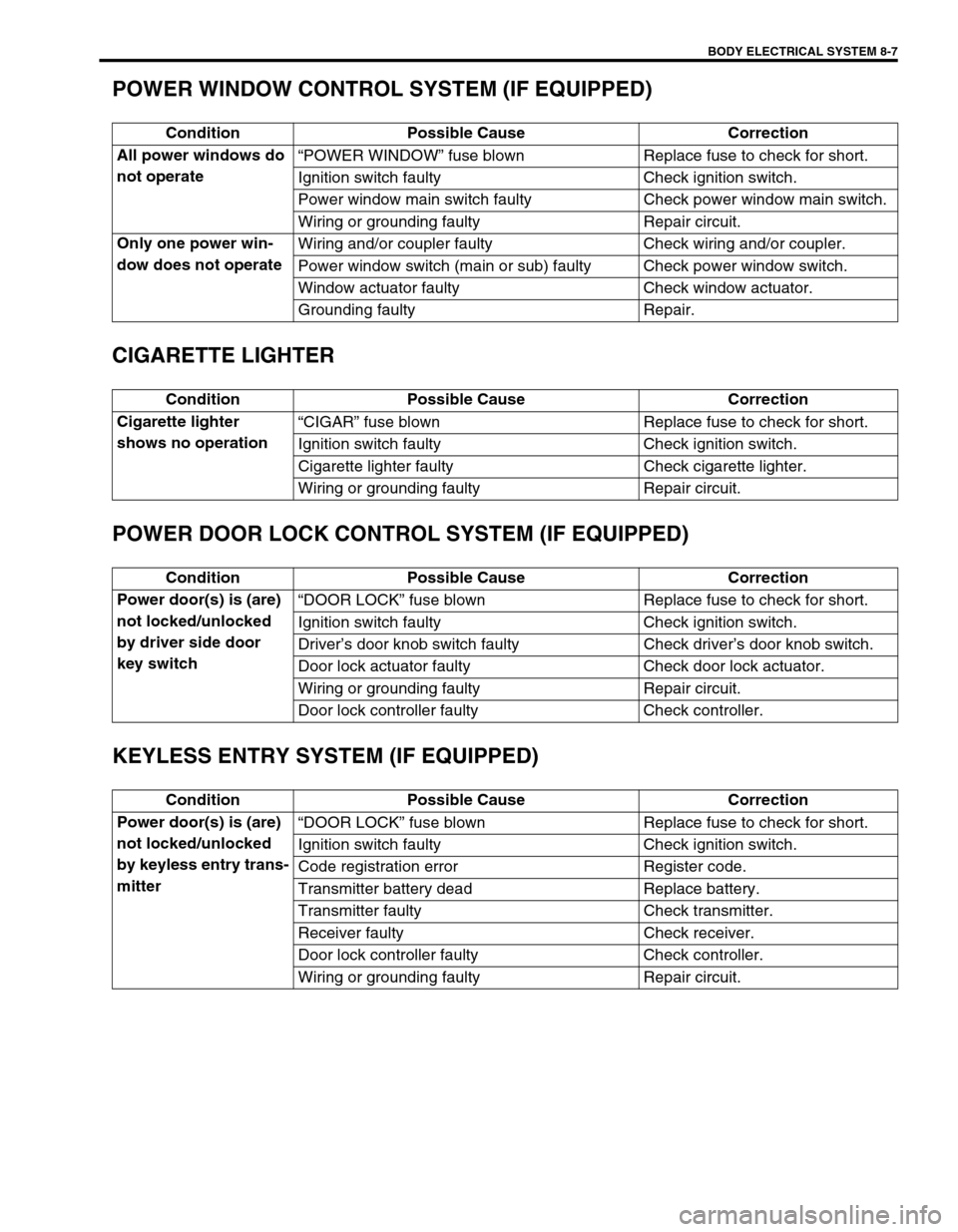
BODY ELECTRICAL SYSTEM 8-7
POWER WINDOW CONTROL SYSTEM (IF EQUIPPED)
CIGARETTE LIGHTER
POWER DOOR LOCK CONTROL SYSTEM (IF EQUIPPED)
KEYLESS ENTRY SYSTEM (IF EQUIPPED)
Condition Possible Cause Correction
All power windows do
not operate“POWER WINDOW” fuse blown Replace fuse to check for short.
Ignition switch faulty Check ignition switch.
Power window main switch faulty Check power window main switch.
Wiring or grounding faulty Repair circuit.
Only one power win-
dow does not operateWiring and/or coupler faulty Check wiring and/or coupler.
Power window switch (main or sub) faulty Check power window switch.
Window actuator faulty Check window actuator.
Grounding faulty Repair.
Condition Possible Cause Correction
Cigarette lighter
shows no operation“CIGAR” fuse blown Replace fuse to check for short.
Ignition switch faulty Check ignition switch.
Cigarette lighter faulty Check cigarette lighter.
Wiring or grounding faulty Repair circuit.
Condition Possible Cause Correction
Power door(s) is (are)
not locked/unlocked
by driver side door
key switch“DOOR LOCK” fuse blown Replace fuse to check for short.
Ignition switch faulty Check ignition switch.
Driver’s door knob switch faulty Check driver’s door knob switch.
Door lock actuator faulty Check door lock actuator.
Wiring or grounding faulty Repair circuit.
Door lock controller faulty Check controller.
Condition Possible Cause Correction
Power door(s) is (are)
not locked/unlocked
by keyless entry trans-
mitter“DOOR LOCK” fuse blown Replace fuse to check for short.
Ignition switch faulty Check ignition switch.
Code registration error Register code.
Transmitter battery dead Replace battery.
Transmitter faulty Check transmitter.
Receiver faulty Check receiver.
Door lock controller faulty Check controller.
Wiring or grounding faulty Repair circuit.
Page 252 of 447
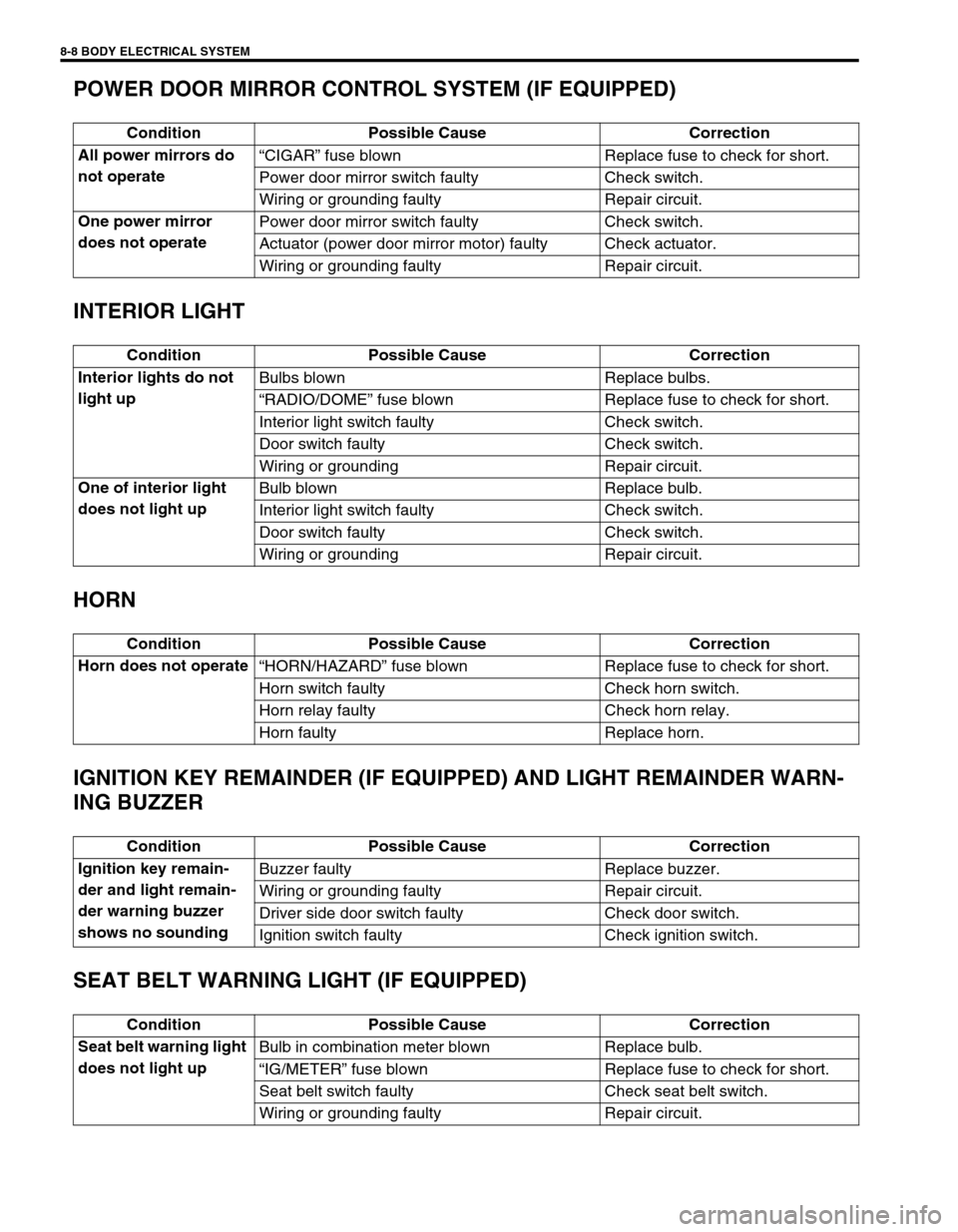
8-8 BODY ELECTRICAL SYSTEM
POWER DOOR MIRROR CONTROL SYSTEM (IF EQUIPPED)
INTERIOR LIGHT
HORN
IGNITION KEY REMAINDER (IF EQUIPPED) AND LIGHT REMAINDER WARN-
ING BUZZER
SEAT BELT WARNING LIGHT (IF EQUIPPED)
Condition Possible Cause Correction
All power mirrors do
not operate“CIGAR” fuse blown Replace fuse to check for short.
Power door mirror switch faulty Check switch.
Wiring or grounding faulty Repair circuit.
One power mirror
does not operatePower door mirror switch faulty Check switch.
Actuator (power door mirror motor) faulty Check actuator.
Wiring or grounding faulty Repair circuit.
Condition Possible Cause Correction
Interior lights do not
light upBulbs blown Replace bulbs.
“RADIO/DOME” fuse blown Replace fuse to check for short.
Interior light switch faulty Check switch.
Door switch faulty Check switch.
Wiring or grounding Repair circuit.
One of interior light
does not light upBulb blown Replace bulb.
Interior light switch faulty Check switch.
Door switch faulty Check switch.
Wiring or grounding Repair circuit.
Condition Possible Cause Correction
Horn does not operate
“HORN/HAZARD” fuse blown Replace fuse to check for short.
Horn switch faulty Check horn switch.
Horn relay faulty Check horn relay.
Horn faulty Replace horn.
Condition Possible Cause Correction
Ignition key remain-
der and light remain-
der warning buzzer
shows no soundingBuzzer faulty Replace buzzer.
Wiring or grounding faulty Repair circuit.
Driver side door switch faulty Check door switch.
Ignition switch faulty Check ignition switch.
Condition Possible Cause Correction
Seat belt warning light
does not light upBulb in combination meter blown Replace bulb.
“IG/METER” fuse blown Replace fuse to check for short.
Seat belt switch faulty Check seat belt switch.
Wiring or grounding faulty Repair circuit.
Page 253 of 447

BODY ELECTRICAL SYSTEM 8-9
FRONT SEAT HEATER (IF EQUIPPED)
ON-VEHICLE SERVICE
CAUTIONS IN SERVICING
When performing works related to electric systems, observe the cautions described in GENERAL INFORMA-
TION (Section 0A) of this manual for the purpose of protection of electrical parts and prevention of a fire from
occurrence.
HEADLIGHT
HEADLIGHT SWITCH
REMOVAL AND INSTALLATION
Refer to “CONTACT COIL AND COMBINATION SWITCH ASSEMBLY” in Section 3C. Condition Possible Cause Correction
Both seat back and
cushion do not
become hot although
seat heater switch is
LO/HI position“SEAT HTR” fuse blown Replace fuse to check for short.
Seat heater switch faulty Check switch.
Seat heater circuit in seat back and/or seat
cushion faultyCheck heater front back and/or
heater front cushion.
Wiring or grounding faulty Repair circuit.
Only seat back does
not become hot
although seat heater
switch is HI positionSeat heater circuit in seat back faulty Check heater front back.
Seat heater switch faulty Check switch.
Wiring faulty Repair.
Only seat cushion
does not become hot
although seat heater
switch is HI positionSeat heater circuit in seat back and/or seat
cushion faultyCheck heater front back and/or
heater front cushion.
Seat heater switch faulty Check switch.
Wiring faulty Repair.
Page 254 of 447
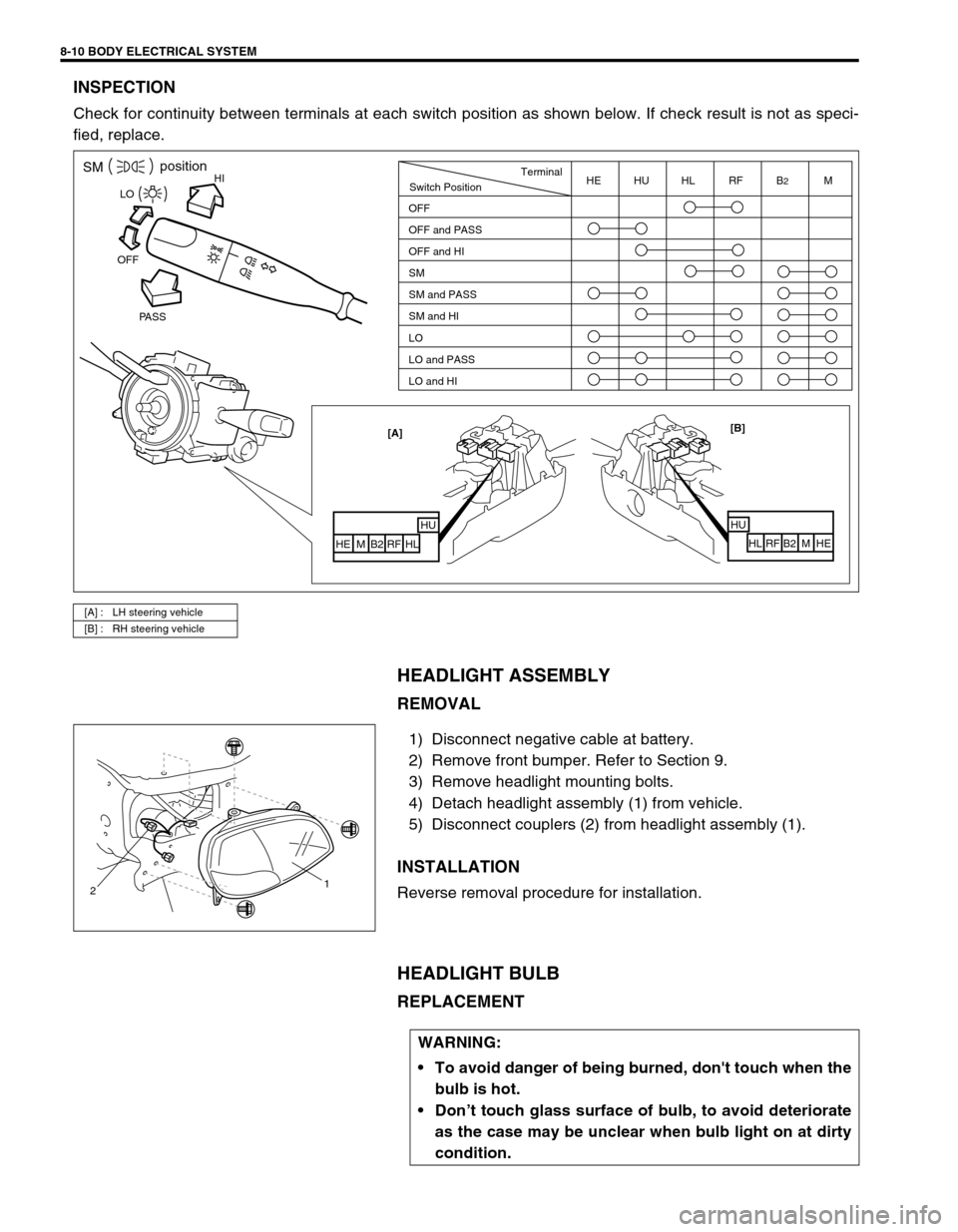
8-10 BODY ELECTRICAL SYSTEM
INSPECTION
Check for continuity between terminals at each switch position as shown below. If check result is not as speci-
fied, replace.
HEADLIGHT ASSEMBLY
REMOVAL
1) Disconnect negative cable at battery.
2) Remove front bumper. Refer to Section 9.
3) Remove headlight mounting bolts.
4) Detach headlight assembly (1) from vehicle.
5) Disconnect couplers (2) from headlight assembly (1).
INSTALLATION
Reverse removal procedure for installation.
HEADLIGHT BULB
REPLACEMENT
[A] : LH steering vehicle
[B] : RH steering vehicle
HISMposition
PASS OFFLO
[B]
HU
HL RF B2 M HE [A]
HUHL
RF B2 M HE
Switch PositionTerminal
OFF
OFF and PASS
OFF and HI
SM
SM and PASS
SM and HI
LO
LO and PASS
LO and HIHE HU HL RF B2M
21
WARNING:
To avoid danger of being burned, don't touch when the
bulb is hot.
Don’t touch glass surface of bulb, to avoid deteriorate
as the case may be unclear when bulb light on at dirty
condition.
Page 255 of 447
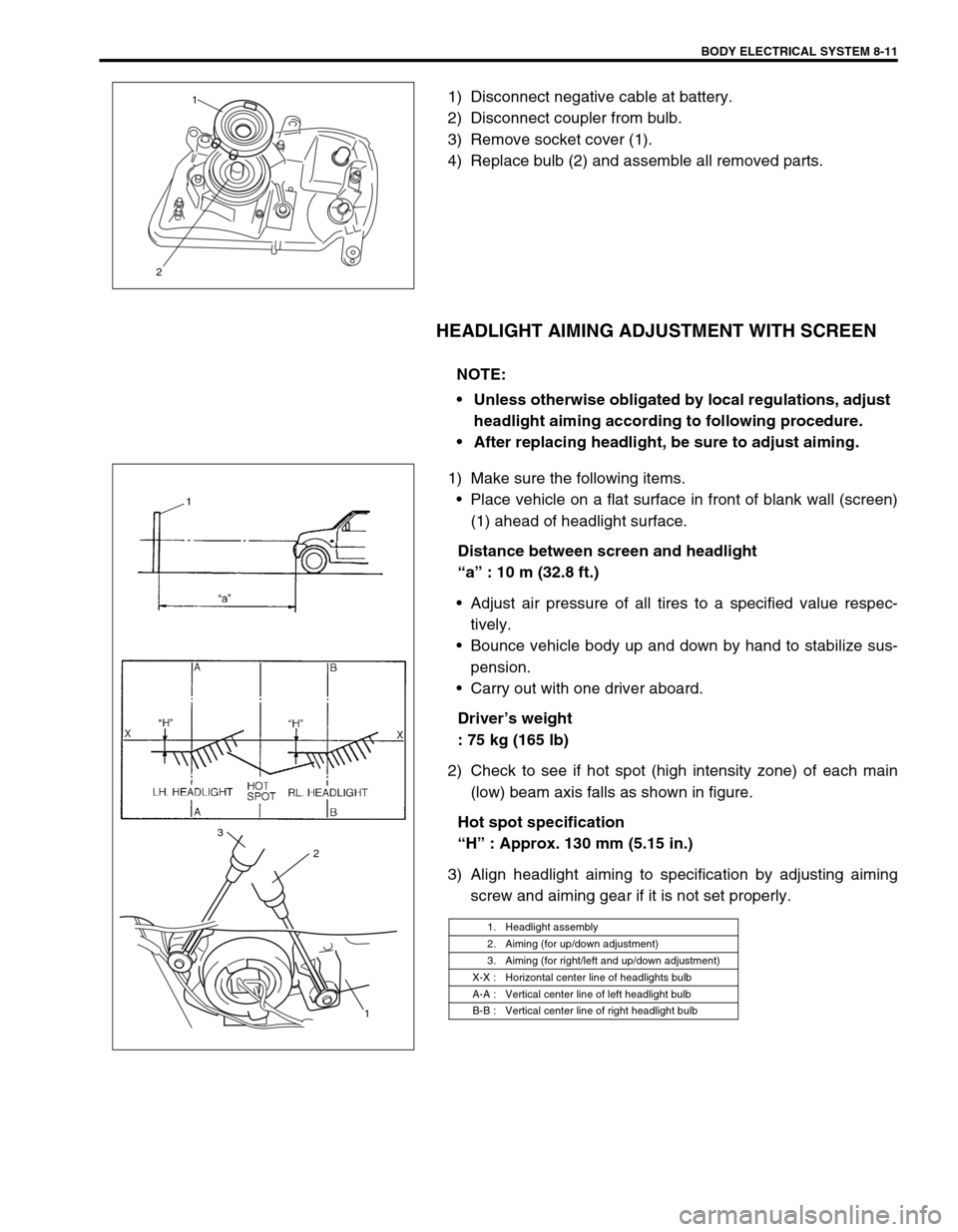
BODY ELECTRICAL SYSTEM 8-11
1) Disconnect negative cable at battery.
2) Disconnect coupler from bulb.
3) Remove socket cover (1).
4) Replace bulb (2) and assemble all removed parts.
HEADLIGHT AIMING ADJUSTMENT WITH SCREEN
1) Make sure the following items.
Place vehicle on a flat surface in front of blank wall (screen)
(1) ahead of headlight surface.
Distance between screen and headlight
“a” : 10 m (32.8 ft.)
Adjust air pressure of all tires to a specified value respec-
tively.
Bounce vehicle body up and down by hand to stabilize sus-
pension.
Carry out with one driver aboard.
Driver’s weight
: 75 kg (165 lb)
2) Check to see if hot spot (high intensity zone) of each main
(low) beam axis falls as shown in figure.
Hot spot specification
“H” : Approx. 130 mm (5.15 in.)
3) Align headlight aiming to specification by adjusting aiming
screw and aiming gear if it is not set properly.
21
NOTE:
Unless otherwise obligated by local regulations, adjust
headlight aiming according to following procedure.
After replacing headlight, be sure to adjust aiming.
1. Headlight assembly
2. Aiming (for up/down adjustment)
3. Aiming (for right/left and up/down adjustment)
X-X : Horizontal center line of headlights bulb
A-A : Vertical center line of left headlight bulb
B-B : Vertical center line of right headlight bulb
1 2 3
Page 256 of 447
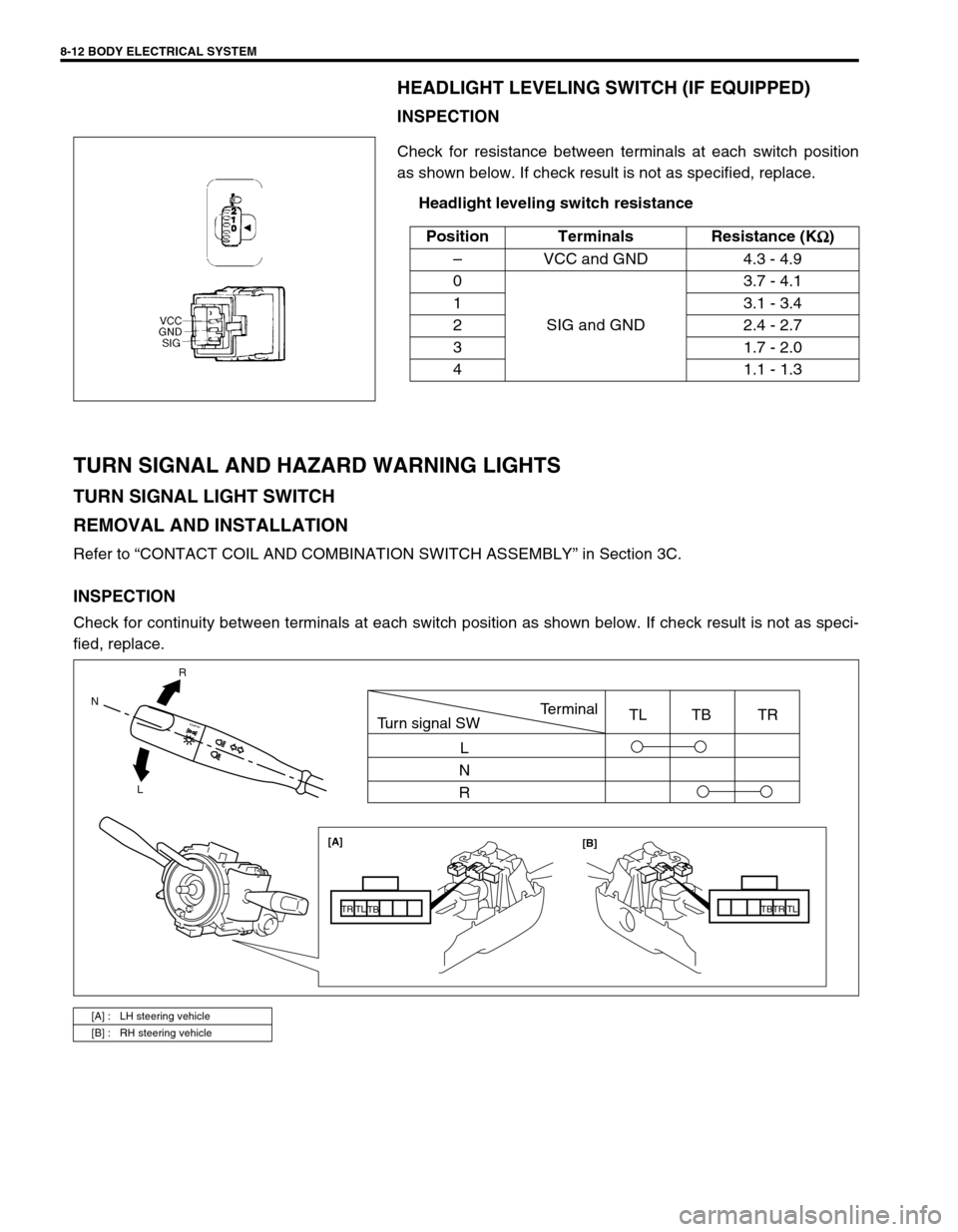
8-12 BODY ELECTRICAL SYSTEM
HEADLIGHT LEVELING SWITCH (IF EQUIPPED)
INSPECTION
Check for resistance between terminals at each switch position
as shown below. If check result is not as specified, replace.
Headlight leveling switch resistance
TURN SIGNAL AND HAZARD WARNING LIGHTS
TURN SIGNAL LIGHT SWITCH
REMOVAL AND INSTALLATION
Refer to “CONTACT COIL AND COMBINATION SWITCH ASSEMBLY” in Section 3C.
INSPECTION
Check for continuity between terminals at each switch position as shown below. If check result is not as speci-
fied, replace.Position Terminals Resistance (K
Ω
ΩΩ Ω)
–VCC and GND 4.3 - 4.9
0
SIG and GND3.7 - 4.1
1 3.1 - 3.4
2 2.4 - 2.7
3 1.7 - 2.0
4 1.1 - 1.3
[A] : LH steering vehicle
[B] : RH steering vehicle
R
L N
[A]
[B]
TB
TBTR TR
TL TL
Turn signal SWTerminal
L
N
RTL TB TR
Page 257 of 447
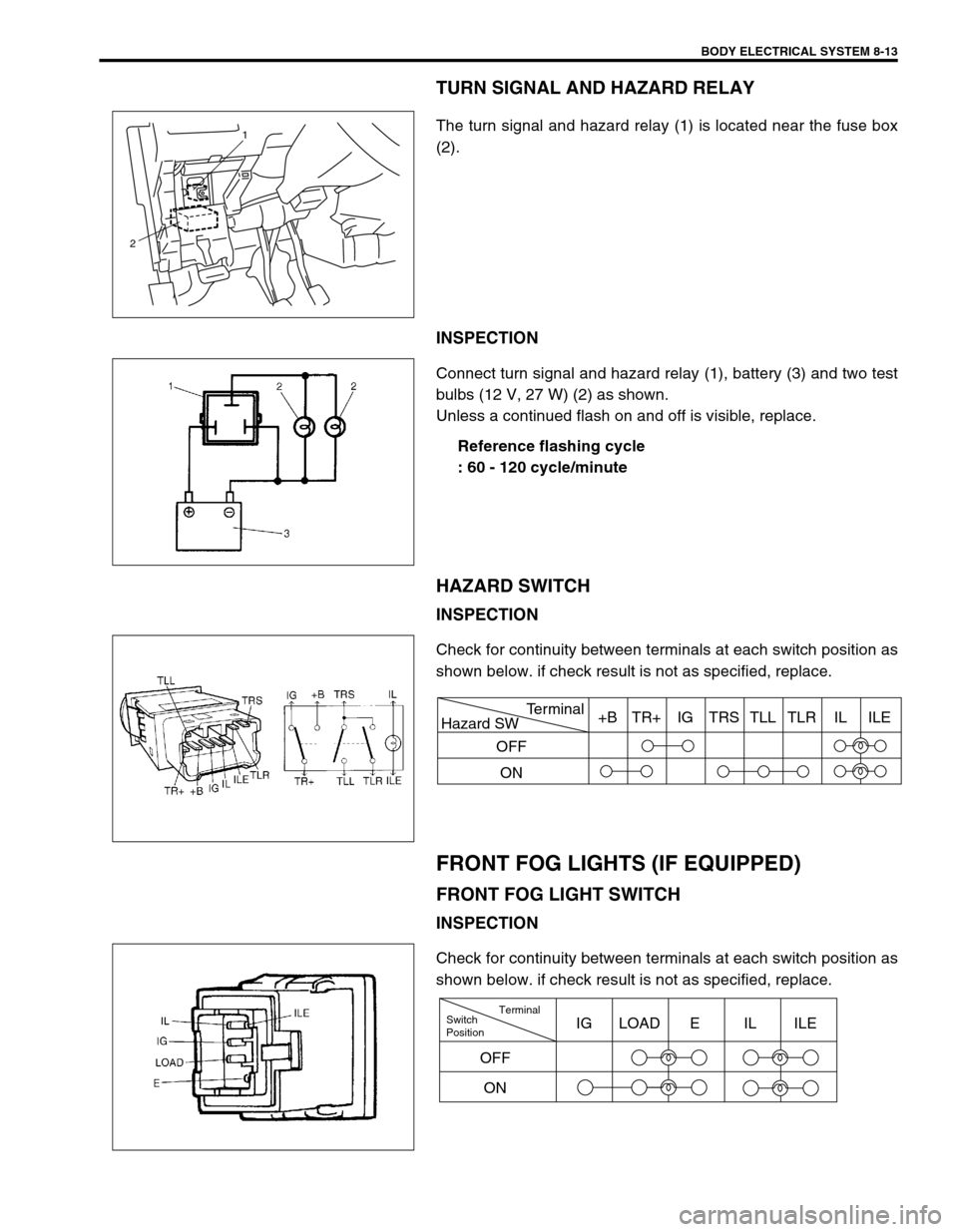
BODY ELECTRICAL SYSTEM 8-13
TURN SIGNAL AND HAZARD RELAY
The turn signal and hazard relay (1) is located near the fuse box
(2).
INSPECTION
Connect turn signal and hazard relay (1), battery (3) and two test
bulbs (12 V, 27 W) (2) as shown.
Unless a continued flash on and off is visible, replace.
Reference flashing cycle
: 60 - 120 cycle/minute
HAZARD SWITCH
INSPECTION
Check for continuity between terminals at each switch position as
shown below. if check result is not as specified, replace.
FRONT FOG LIGHTS (IF EQUIPPED)
FRONT FOG LIGHT SWITCH
INSPECTION
Check for continuity between terminals at each switch position as
shown below. if check result is not as specified, replace.
1
2
Hazard SWTerminal
OFF
ON+B TR+ IG TRS TLL TLR IL ILE
Switch
PositionTerminal
ONIG LOAD E IL ILE
OFF
Page 258 of 447
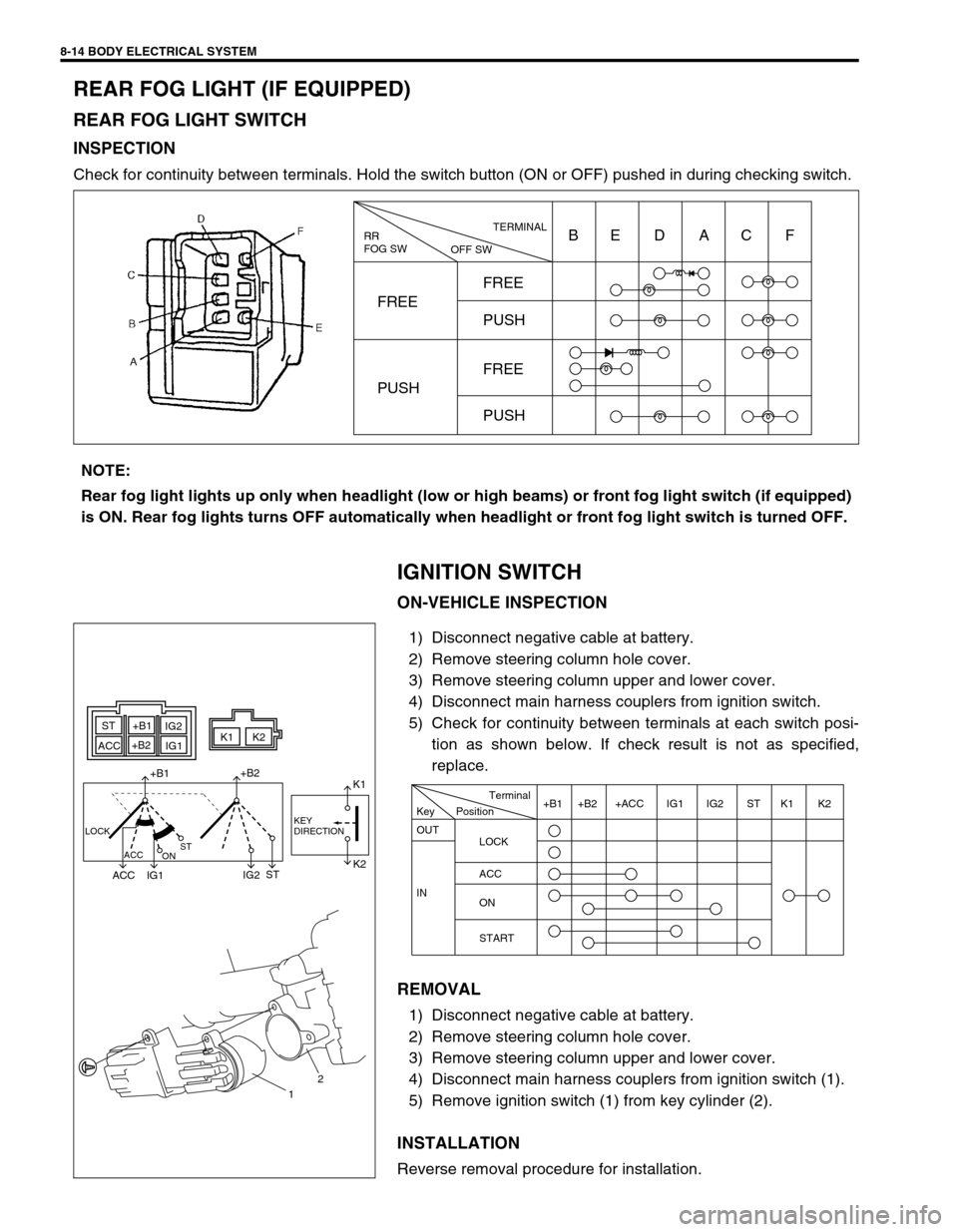
8-14 BODY ELECTRICAL SYSTEM
REAR FOG LIGHT (IF EQUIPPED)
REAR FOG LIGHT SWITCH
INSPECTION
Check for continuity between terminals. Hold the switch button (ON or OFF) pushed in during checking switch.
IGNITION SWITCH
ON-VEHICLE INSPECTION
1) Disconnect negative cable at battery.
2) Remove steering column hole cover.
3) Remove steering column upper and lower cover.
4) Disconnect main harness couplers from ignition switch.
5) Check for continuity between terminals at each switch posi-
tion as shown below. If check result is not as specified,
replace.
REMOVAL
1) Disconnect negative cable at battery.
2) Remove steering column hole cover.
3) Remove steering column upper and lower cover.
4) Disconnect main harness couplers from ignition switch (1).
5) Remove ignition switch (1) from key cylinder (2).
INSTALLATION
Reverse removal procedure for installation.
RR
FOG SW
OFF SWTERMINAL
FREEFREE
PUSH
FREE
PUSH PUSHBE D AC F
NOTE:
Rear fog light lights up only when headlight (low or high beams) or front fog light switch (if equipped)
is ON. Rear fog lights turns OFF automatically when headlight or front fog light switch is turned OFF.
ST+B1
+B2
ACCIG2
IG1K1K2
+B1+B2
ACC IG1IG2STK1
K2
LOCK
ACC
ONSTKEY
DIRECTION
12
Position Key
OUT
LOCK
ACC
ON
START IN+B1 +B2 +ACC IG1 IG2 ST K1 K2 Terminal
Page 259 of 447
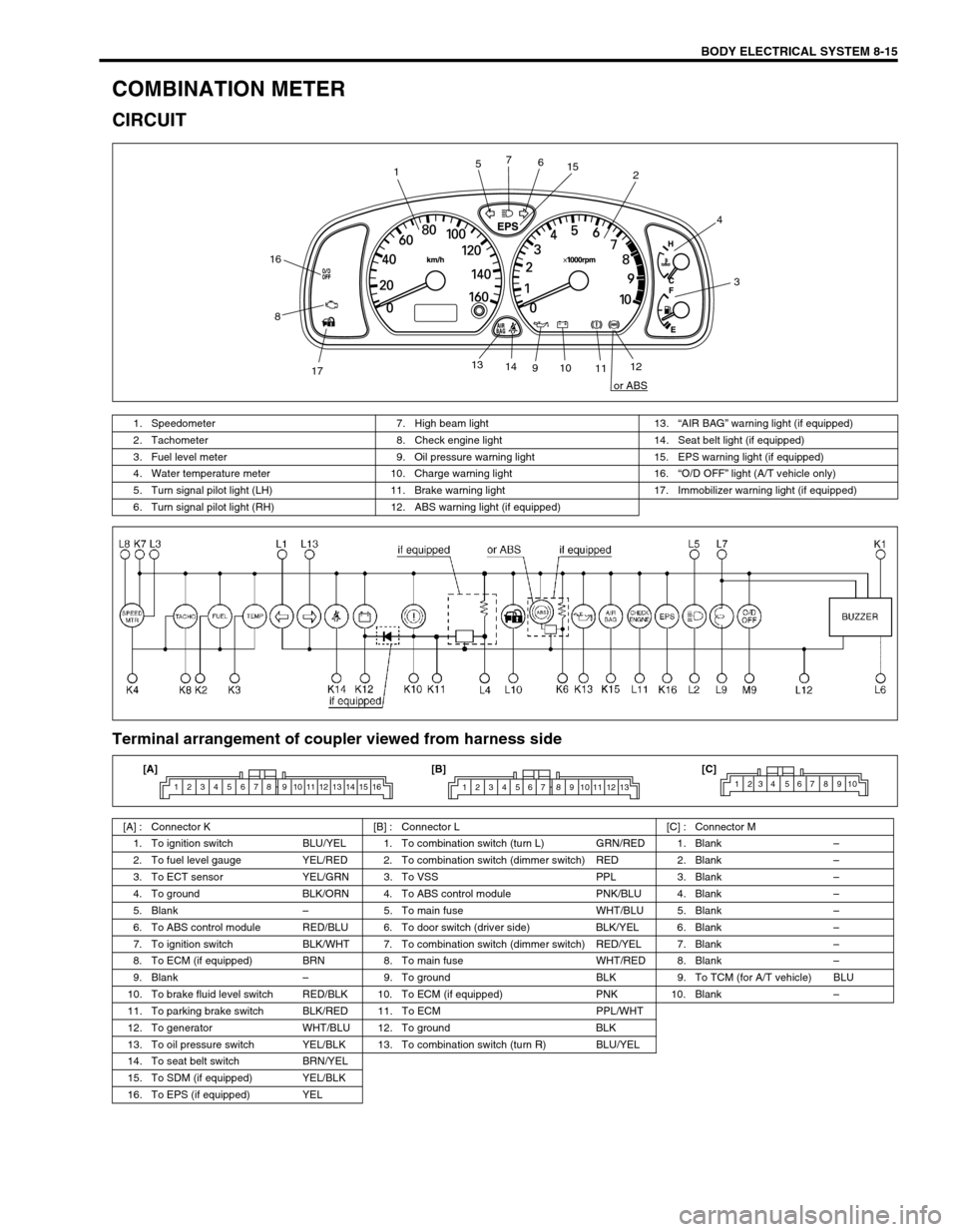
BODY ELECTRICAL SYSTEM 8-15
COMBINATION METER
CIRCUIT
Terminal arrangement of coupler viewed from harness side
12
3 4
56 7
8
910
1112 13
14
1715
16
or ABS
1. Speedometer 7. High beam light 13.“AIR BAG” warning light (if equipped)
2. Tachometer 8. Check engine light 14. Seat belt light (if equipped)
3. Fuel level meter 9. Oil pressure warning light 15. EPS warning light (if equipped)
4. Water temperature meter 10. Charge warning light 16.“O/D OFF” light (A/T vehicle only)
5. Turn signal pilot light (LH) 11. Brake warning light 17. Immobilizer warning light (if equipped)
6. Turn signal pilot light (RH) 12. ABS warning light (if equipped)
[A] : Connector K [B] : Connector L [C] : Connector M
1. To ignition switch BLU/YEL 1. To combination switch (turn L) GRN/RED 1. Blank–
2. To fuel level gauge YEL/RED 2. To combination switch (dimmer switch) RED 2. Blank–
3. To ECT sensor YEL/GRN 3. To VSS PPL 3. Blank–
4. To ground BLK/ORN 4. To ABS control module PNK/BLU 4. Blank–
5. Blank–5. To main fuse WHT/BLU 5. Blank–
6. To ABS control module RED/BLU 6. To door switch (driver side) BLK/YEL 6. Blank–
7. To ignition switch BLK/WHT 7. To combination switch (dimmer switch) RED/YEL 7. Blank–
8. To ECM (if equipped) BRN 8. To main fuse WHT/RED 8. Blank–
9. Blank–9. To ground BLK 9. To TCM (for A/T vehicle) BLU
10. To brake fluid level switch RED/BLK 10. To ECM (if equipped) PNK 10. Blank–
11. To parking brake switch BLK/RED 11. To ECM PPL/WHT
12. To generator WHT/BLU 12. To ground BLK
13. To oil pressure switch YEL/BLK 13. To combination switch (turn R) BLU/YEL
14. To seat belt switch BRN/YEL
15. To SDM (if equipped) YEL/BLK
16. To EPS (if equipped) YEL
1 2 3 4 5 6 7 8 9 10 11 12 13 14 15 161 2 3 4 5 6 7 8 9 10 11 12 131234 567 8910[A] [B] [C]
Page 260 of 447
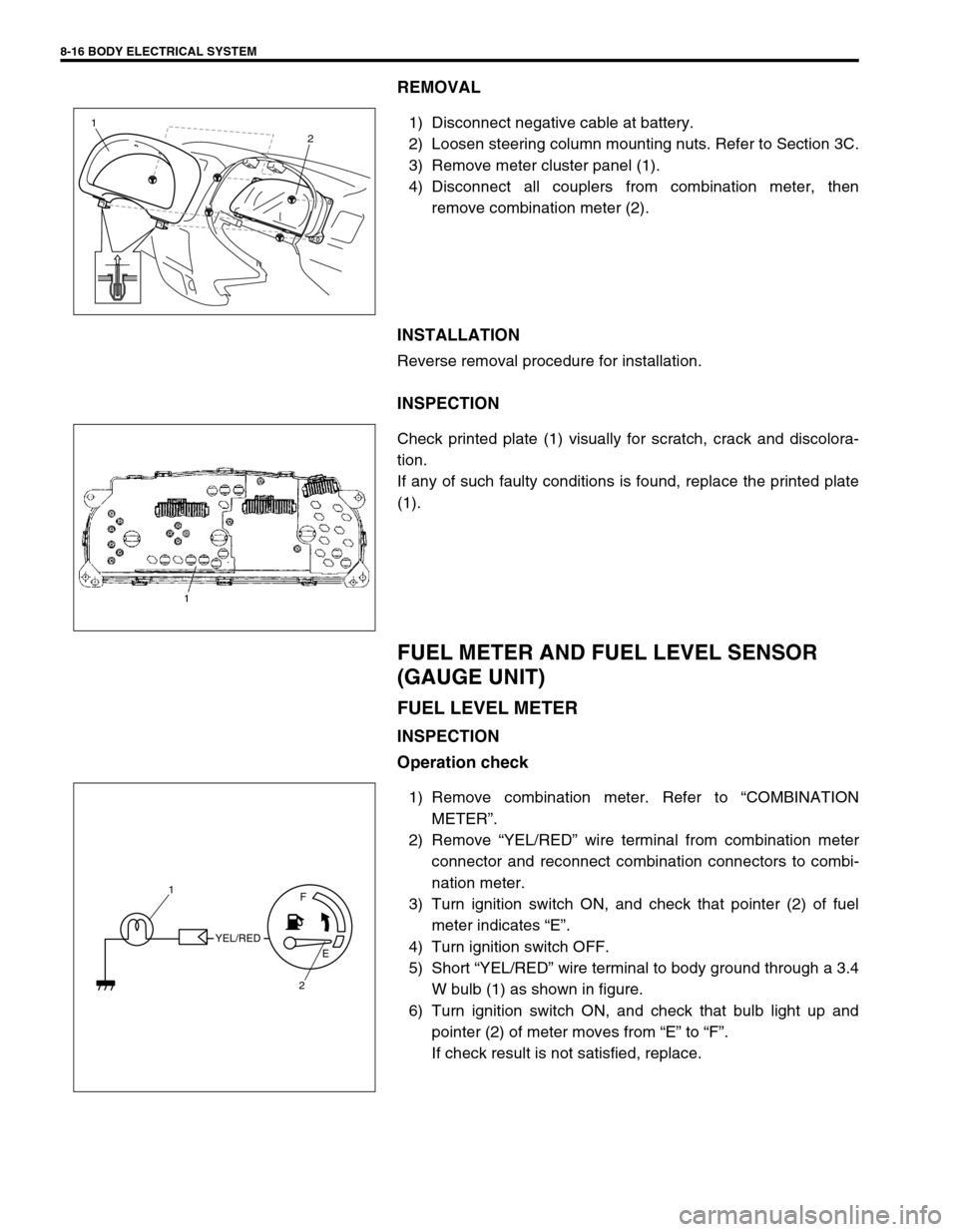
8-16 BODY ELECTRICAL SYSTEM
REMOVAL
1) Disconnect negative cable at battery.
2) Loosen steering column mounting nuts. Refer to Section 3C.
3) Remove meter cluster panel (1).
4) Disconnect all couplers from combination meter, then
remove combination meter (2).
INSTALLATION
Reverse removal procedure for installation.
INSPECTION
Check printed plate (1) visually for scratch, crack and discolora-
tion.
If any of such faulty conditions is found, replace the printed plate
(1).
FUEL METER AND FUEL LEVEL SENSOR
(GAUGE UNIT)
FUEL LEVEL METER
INSPECTION
Operation check
1) Remove combination meter. Refer to “COMBINATION
METER”.
2) Remove “YEL/RED” wire terminal from combination meter
connector and reconnect combination connectors to combi-
nation meter.
3) Turn ignition switch ON, and check that pointer (2) of fuel
meter indicates “E”.
4) Turn ignition switch OFF.
5) Short “YEL/RED” wire terminal to body ground through a 3.4
W bulb (1) as shown in figure.
6) Turn ignition switch ON, and check that bulb light up and
pointer (2) of meter moves from “E” to “F”.
If check result is not satisfied, replace.
1
2
YEL/REDF
E
2 1